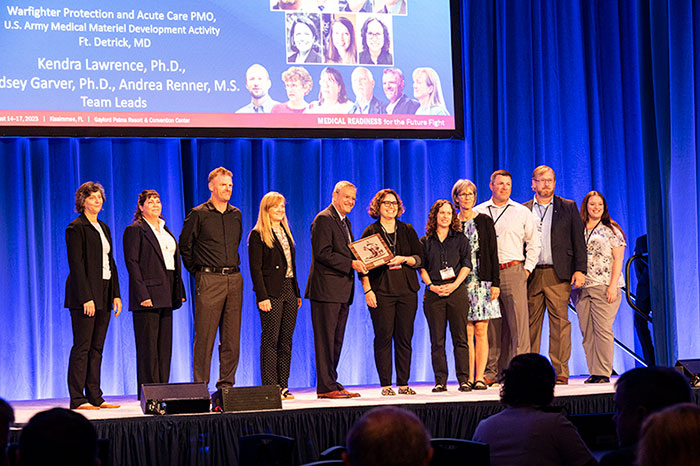

Members of the Warfighter Protection and Acute Care Project Management Office were recognized for program management excellence during the annual Military Health System Research Symposium in Kissimmee, Florida, August 14.
The WPAC team, part of the U.S. Army Medical Materiel Development Activity at Fort Detrick, Maryland, develops, delivers, and fields U.S. Food and Drug Administration-approved preventions, diagnostics, and treatments to help protect and preserve the lives of U.S. service members.
They received the MHSRS and Defense Health Agency award for Program Management for their work to develop a Broad-Spectrum Snakebite Antidote.
“This award is a direct reflection of the incredible work of the entire BSSA and WPAC team, and I am proud and humble to be able to lead the men and women who work so hard to address the needs of our Warfighters,” said Kendra Lawrence, Ph. D., WPAC Project Manager. “The strength of the WPAC team lies in its mission focus, collaborative approach, and vision to help enable combat casualty care capabilities at or near the point of injury. This award symbolizes the dedication of our team in developing and delivering the highest quality medical solutions and capabilities for our men and women in uniform.”
During 2022, the capability to treat snakebite envenoming made a giant leap forward with clinical trial testing under real-world conditions and the FDA’s “Fast-Track” designation of Varespladib. This small-molecule drug candidate was funded by the Defense Health Program and developed in collaboration with a non-Department of Defense partner, according to Lindsey Garver, Ph.D., Deputy Project Manager for WPAC.
“The BSSA program seeks to develop a shelf-stable treatment for snakebite envenoming that is safe, easy to use by individuals in far-forward austere environments, and is independent of snake species,” said Garver. “[Antivenom] is typically species-specific, which means you need to know which snake bit you to be treated with the proper antivenom. This also means the military must stock and know how to use multiple types of antivenom to treat bites from different species. There are some species for which no antivenom exists, meaning the only treatment is supportive care. This program seeks to provide a solution to all these issues.”
As U.S. Joint Forces continue to develop expeditionary capabilities for the coastal regions of the Indo-Pacific, where logistics trains must extend across hundreds or thousands of miles, having a ready solution to treat service members for snakebite envenomation will place an added tool in medical aid bags while higher echelon care is arranged, Garver believes.
“This product is really designed to counter the far-forward threat of snakebites,” said Garver. “There is an inverse relationship as service members move into more austere conditions, where the threat of snakebites goes up and access to higher echelons of care goes down. A successful BSSA product extends easy, effective treatment into those austere conditions, supporting the independent maneuver of small teams and widening the window of time needed for evacuation in the event of a bite.”
While clinical trials are ongoing in the U.S. and India, pre-clinical studies and information about the mechanism of action of the BSSA drug suggest it can be used worldwide.

